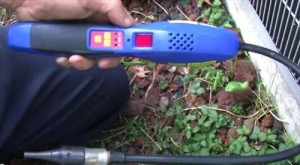
Finding a refrigerant leak in an HVAC system can be easy at times, and other times, almost impossible.
One method is to use a bubbly liquid sprayed around where a possible leak is to visibly see the location of the leak. Using this method does work but often requires lots of time, especially for small, difficult-to-find leaks.
Also, If a system has a very low charge, the unit will need to be charged with Nitrogen to raise the pressure.
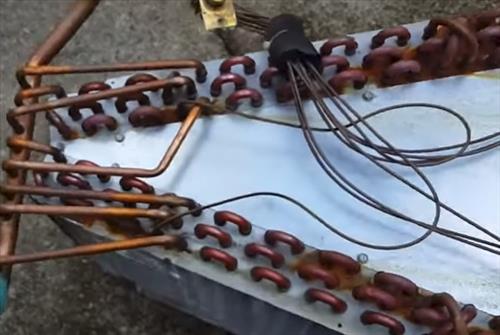
Another method to find hard-to-spot leaks is to use a leak detector that will detect refrigerant.
Every HVAC tech will have their own favorite method of finding a leak. In my experience, using both the soap method, fluorescent dyes, and leak detector method have their advantages.
What is a Refrigerant Leak Detector?
A refrigerant leak detector is basically an electronic nose that can sniff out HVAC refrigerants.
Refrigerant leak detectors can make it much easier and quicker to find a refrigerant leak in an HVAC system.
In the past, leak detectors were notoriously bad at finding a refrigerant leak, but technology today has changed with many good ones available.
Refrigerant leak detectors vary in build and cost. What fits one technician often doesn’t fit another.
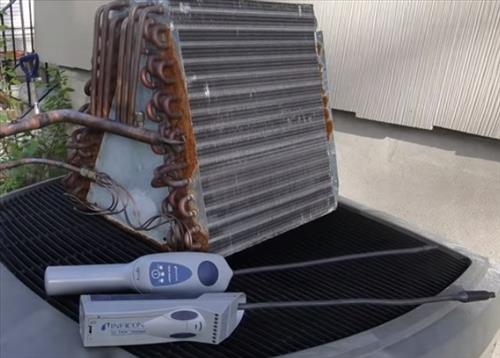
The best method to find the right leak detector that fits you is to read the reviews on forums, Amazon, or other sources from real techs in the field already using it.
Below are our picks for the best HVAC Leak detectors with links to Amazon.
As always, be sure to read the reviews on Amazon, forums, or elsewhere to be sure a unit is a good fit for you.
*This post contains affiliate links.
Our Picks for the Best HVAC Refrigerant Leak Detectors
- Yellow Jacket 69336 AccuProbe
- Elitech ILD-200
- H10 Pro
- Yosoo hld-100+
- Elitech WJL-6000
- Fieldpiece SRL8
Yellow Jacket is another well-known HVAC equipment manufacturer that makes many good tools.
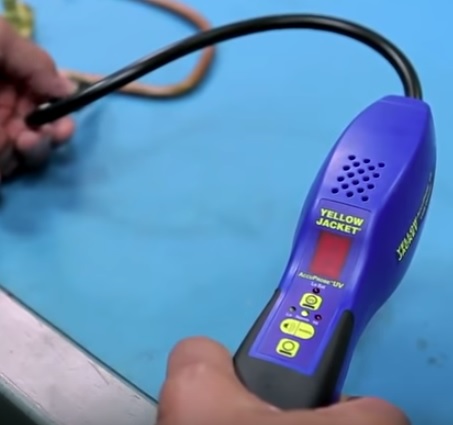
The Yellow Jacket AccuProbe is also built for professionals to find refrigerant leaks on an HVAC system.
The unit has a lot of features, uses 4 AAA batteries, and has a UV light at the tip.
The display will show a number 1-9 to indicate how big a leak is found.
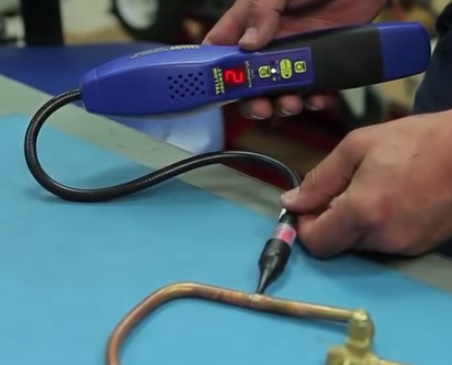
The unit works by detecting changes in the refrigerant. This means that when using it move away from the possible leak for a moment and back again.
Moving the unit around gives the best results when trying to find a leak.
The Accuprobe also features a three-led UV light system.
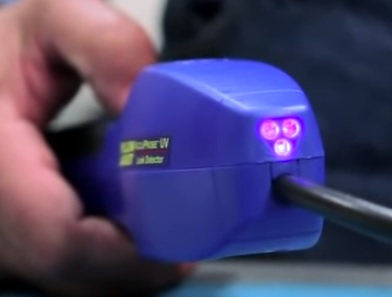
It works with 395-415 nano-meter wavelength leak tracing dyes for use on systems that were either installed with or have had dye injected in past service calls.
The AccuProbe is a good unit that has helped many techs find and repair refrigerant leaks.
The Elitech ILD-200 is built for the professional HVAC tech with a good warranty and made to last many years.
It has visual and audible alarms along with strength levels to show where a leak is and when it is close.
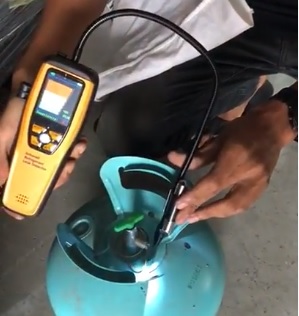
The probe is flexible and easy to move about to find even the smallest hard-to-find leak.
It also has many built-in features, such as three sensitivity settings to help narrow in on a hole.
The Elitech ILD-200 is a great unit made for those who plan on working in the HVAC field for many years.
The H10 Pro is another top-end unit that has helped many HVAC techs find a leak.
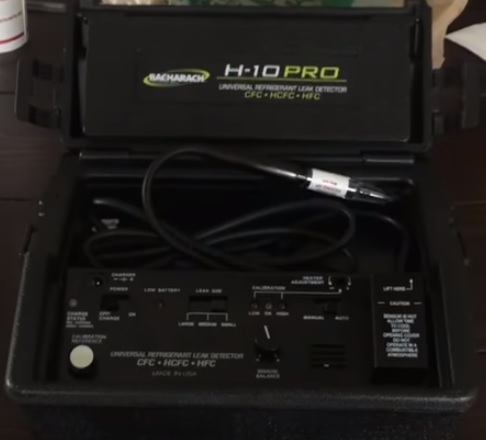
The unit comes in a small case with nicely laid out controls and a long sniffer.
It makes an audible tick, and the tip has a light, with both going faster the closer to a leak it is.
The unit is powered by a rechargeable battery or external DC adapter.
This unit is cheap compared to the other leak detectors. The cost makes me a little wary of how well it would work in the field.
While it can’t be compared to the top name-brand units, it would be good in some scenarios, just don’t expect wonders.
Elitech WJL-6000 is a low-cost budget unit that, while not as good as other units, would be good in some scenarios.
The tip is flexible to bend and move about to get in close to find small hard to detect leaks.
It has a light and beeps when a leak is found.
While small and kinda cheap looking, it does work. It is not meant as a professional tool but works well enough for those looking for a budget unit.
Fieldpiece is a well-known HVAC tool manufacturer and builds the SRL8 refrigerant leak detector.
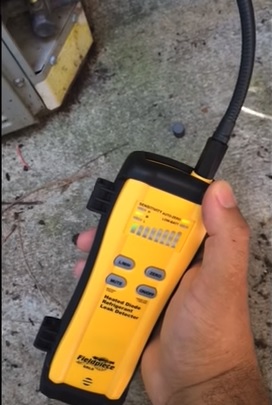
It is a good unit that is used by many professional HVAC technicians.
It can sniff out almost any refrigerant, including CFCs, HFCs, HCFCs, and other blends.
The unit works very well with HFC refrigerants such as R134a and R404a.
It is less sensitive to CFC refrigerants such as R-410A or R-22.
The Fieldpiece SRL8 is a great unit that is a good fit in any HVAC tool kit able to quickly find a leak on many systems.
HVAC Refrigerant Leak Detectors Comparison Chart
| Name | Build | CFC / HFC | Type |
|---|---|---|---|
| Yellow Jacket AccuProbe | Professional | Yes | Handheld |
| Elitech ILD-200 | Professional | Yes | Portable case |
| H10 Pro | Professional | Yes | Handheld |
| Yosoo hld-100+ | Budget | Yes | Handheld |
| Elitech WJL-6000 | Budget | Yes | Handheld |
| Fieldpiece SRL8 | Professional | Yes | Handheld |
What is a Refrigerant leak?
A refrigerant leak is when an HVAC system has a hole in the unit somewhere and leaking the refrigerant it uses to operate.
All HVAC units use refrigerant in a cycle to heat or cool.
When an HVAC system has a leak, the refrigerant can escape causing the unit to stop working correctly.
The leak will need to be found and sealed before the new refrigerant can be put back in.
How Do You Check for an HVAC Refrigerant Leaks?
A refrigerant leak can be found with a leak detector, dyes, or soap and water.
Often a combination of the three is used to help narrow down the leaking spot.
An electronic leak detector is the most common method since it can quickly pinpoint a leaking spot.
Dyed can also be used, which are let into the system and leak out of the leaking location.
Soap and water while old school can still work well in many scenarios to find a leaking refrigerant location.
What Does an HVAC Refrigerant Leak Smell Like?
Most people describe a refrigerant leak as a sweet chloroform scent.
It can also smell like oil and usually has an oily spot where the leak is located.
How Do Refrigerant Leak Detectors Work?
HVAC leak detectors use different sensor technologies to detect refrigerants such as diode refrigerant leak detectors.
Heated Diode refrigerant leak detector units work when gases come in contact with the unit and produce a small electrical current.
Solid-State sensors use a metal oxide heating element that detects conductivity changes.
When gas is absorbed into the heating element, it changes the conductivity, which can be measured and detect gasses.
Ultrasonic sniffers identify sound waves that are emitted when gas escapes from a leak.
When gas is pressurized, it generates a sound in the 25kHz-10MHz frequencies.
This sound can be listened for electronically and give a beep when detected.
Ultrasonic units can detect any type of gas but cant detect how much of the refrigerant or the amount there is.
How Do You Fix an HVAC Refrigerant Leak?
First, the leak needs to be found, and location marked.
Once it is found, the location can often dictate if the leak can be fixed.
If it has a bad solder point is located, the joint can simply be re-soldered together.
Other locations can be more difficult; for example, the coils are often very hard to solder back together.
The main goal is to find the leak and then fix it, usually with solder.
How is an HVAC Refrigerant Leak Tested?
After a refrigerant leak is fixed, an HVAC vacuum pump is used to place a vacuum on the system.
HVAC gauges are used to measure the vacuum and see if it holds.
If the vacuum holds, the unit is not leaking, and refrigerant can be let back in.
Alternatively, Nitrogen can also be used to pressure test the system for leaks.
A Nitrogen tank is used along with HVAC gauges to pressurize the system.
If there is still a leak, the Nitrogen will leak out, and the leak needs to be fixed.
If no Nitrogen comes out, the unit can be filled with refrigerant and put back into service.
Summary
HVAC equipment such as an electronic refrigerant leak detector is not usually low-cost.
There are many HVAC detectors on the market, including technologies such as heated diode refrigerant leak detectors and infrared refrigerant sensors that can find a variety of refrigerants.
While an advanced refrigerant leak detector usually works very well, there can be a false alarm in some scenarios.
Another method can be used to verify a leak if there is a suspected false alarm.
Build quality is also a consideration, with most units built to last a long while.
Sensitivity levels and the types of refrigerants should all be considered.
Have you found a good HVAC refrigerant detector? Let us know in the comments below.
Lots of people have “broken” window AC units. They give them away on FreeCycle all the time.
I am not a HVAC guy, but I think it is criminal that the mfg’s are allowed to produce these things without ports and with copper lines that can’t stand the use they are under.
Are there cheap <$100 leak detectors for a do gooder hobbyist like me.
Many of these throw away units can be repaired with new run caps or a charge. When I was young I paid $50 to a reputable company (they are still around) who fixed my sleeve unit for $50. (I had to bring the unite in) It had already had a saddle valve which they replaced with a proper port. This will require finding the leak, but I am not going to buy a $400 leak detector. I don't need rugged or fancy displays, just the beep. With 36 million people unemployed I am sure some of them don't have $200 for a new AC unit.
The H-10 Refrigeration leak detector is boss. I find a lot of leaks with that. As you know Rack system can be a pain to find Refrigeration leak.
I still preferred the traditional way of leak detecting…most of the time electronic leak detector failed just rely on senses and experience its much better
Why are all these evaporator coils leaking lately? They need to find out how they made coils in the old days and do it that way again. I can’t believe how many coils we replaced this year even ones under warranty. Maybe once they have to keep replacing warranted coils the will decide to make them better.